Cover
Half-title
Series-title
Title
Copyright
Dedication
Contents
Introduction to the Tenth Anniversary Edition
Afterword to the Tenth Anniversary Edition
Preface
Structure of the book
How to use this book
Acknowledgements
Nomenclature and notation
Linear algebra and quantum mechanics
Information theory and probability
Miscellanea
Frequently used quantum gates and circuit symbols
I Fundamental concepts
1 Introduction and overview
1.1 Global perspectives
1.1.1 History of quantum computation and quantum information
Any algorithmic process can be simulated efficiently using a Turing machine
Any algorithmic process can be simulated efficiently using a probabilistic Turing machine
1.1.2 Future directions
1.2 Quantum bits
1.2.1 Multiple qubits
1.3 Quantum computation
1.3.1 Single qubit gates
1.3.2 Multiple qubit gates
1.3.3 Measurements in bases other than the computational basis
1.3.4 Quantum circuits
1.3.5 Qubit copying circuit?
1.3.6 Example: Bell states
1.3.7 Example: quantum teleportation
1.4 Quantum algorithms
1.4.1 Classical computations on a quantum computer
1.4.2 Quantum parallelism
1.4.3 Deutsch’s algorithm
1.4.4 The Deutsch–Jozsa algorithm
1.4.5 Quantum algorithms summarized
Quantum algorithms based upon the Fourier transform
Quantum search algorithms
Quantum simulation
The power of quantum computation
1.5 Experimental quantum information processing
1.5.1 The Stern–Gerlach experiment
1.5.2 Prospects for practical quantum information processing
1.6 Quantum information
1.6.1 Quantum information theory: example problems
Classical information through quantum channels
Quantum information through quantum channels
Quantum distinguishability
1.6.2 Quantum information in a wider context
History and further reading
2 Introduction to quantum mechanics
2.1 Linear algebra
2.1.1 Bases and linear independence
2.1.2 Linear operators and matrices
2.1.3 The Pauli matrices
2.1.4 Inner products
2.1.5 Eigenvectors and eigenvalues
2.1.6 Adjoints and Hermitian operators
2.1.7 Tensor products
2.1.8 Operator functions
2.1.9 The commutator and anti-commutator
2.1.10 The polar and singular value decompositions
2.2 The postulates of quantum mechanics
2.2.1 State space
2.2.2 Evolution
2.2.3 Quantum measurement
2.2.4 Distinguishing quantum states
2.2.5 Projective measurements
2.2.6 POVM measurements
2.2.7 Phase
2.2.8 Composite systems
2.2.9 Quantum mechanics: a global view
2.3 Application: superdense coding
2.4 The density operator
2.4.1 Ensembles of quantum states
2.4.2 General properties of the density operator
2.4.3 The reduced density operator
2.5 The Schmidt decomposition and purifications
2.6 EPR and the Bell inequality
History and further reading
3 Introduction to computer science
3.1 Models for computation
3.1.1 Turing machines
3.1.2 Circuits
3.2 The analysis of computational problems
3.2.1 How to quantify computational resources
Asymptotic notation: examples
3.2.2 Computational complexity
3.2.3 Decision problems and the complexity classes P and NP
3.3 Perspectives on computer science
History and further reading
II Quantum computation
4 Quantum circuits
4.1 Quantum algorithms
4.2 Single qubit operations
4.3 Controlled operations
4.4 Measurement
4.5 Universal quantum gates
4.5.1 Two-level unitary gates are universal
4.5.2 Single qubit and CNOT gates are universal
4.5.3 A discrete set of universal operations
Approximating unitary operators
Universality of Hadamard + phase…
4.5.4 Approximating arbitrary unitary gates is generically hard
4.5.5 Quantum computational complexity
4.6 Summary of the quantum circuit model of computation
4.7 Simulation of quantum systems
4.7.1 Simulation in action
4.7.2 The quantum simulation algorithm
4.7.3 An illustrative example
4.7.4 Perspectives on quantum simulation
History and further reading
5 The quantum Fourier transform and its applications
5.1 The quantum Fourier transform
5.2 Phase estimation
5.2.1 Performance and requirements
5.3 Applications: order-finding and factoring
5.3.1 Application: order-finding
The continued fraction expansion
Performance
5.3.2 Application: factoring
5.4 General applications of the quantum Fourier transform
5.4.1 Period-finding
5.4.2 Discrete logarithms
5.4.3 The hidden subgroup problem
5.4.4 Other quantum algorithms?
History and further reading
6 Quantum search algorithms
6.1 The quantum search algorithm
6.1.1 The oracle
6.1.2 The procedure
6.1.3 Geometric visualization
6.1.4 Performance
6.2 Quantum search as a quantum simulation
6.3 Quantum counting
6.4 Speeding up the solution of NP-complete problems
6.5 Quantum search of an unstructured database
6.6 Optimality of the search algorithm
6.7 Black box algorithm limits
History and further reading
7 Quantum computers: physical realization
7.1 Guiding principles
7.2 Conditions for quantum computation
7.2.1 Representation of quantum information
7.2.2 Performance of unitary transformations
7.2.3 Preparation of fiducial initial states
7.2.4 Measurement of output result
7.3 Harmonic oscillator quantum computer
7.3.1 Physical apparatus
7.3.2 The Hamiltonian
7.3.3 Quantum computation
7.3.4 Drawbacks
Harmonic oscillator quantum computer
7.4 Optical photon quantum computer
7.4.1 Physical apparatus
7.4.2 Quantum computation
7.4.3 Drawbacks
Optical photon quantum computer
7.5 Optical cavity quantum electrodynamics
7.5.1 Physical apparatus
Fabry–Perot cavity
Two-level atoms
7.5.2 The Hamiltonian
7.5.3 Single-photon single-atom absorption and refraction
7.5.4 Quantum computation
Optical cavity quantum electrodynamics
7.6 Ion traps
7.6.1 Physical apparatus
Trap geometry and lasers
Atomic structure
7.6.2 The Hamiltonian
7.6.3 Quantum computation
Single qubit operations
Controlled phase-flip gate
Swap gate
Controlled-NOT gate
Ion trap quantum computer
7.7 Nuclear magnetic resonance
7.7.1 Physical apparatus
7.7.2 The Hamiltonian
Single spin dynamics
Spin–spin couplings
Thermal equilibrium
Magnetization readout
Decoherence
7.7.3 Quantum computation
Refocusing
Controlled-NOT gate
Temporal, spatial, and logical labeling
Ensemble readout of quantum algorithm results
7.7.4 Experiment
State tomography
Quantum logic gates
Quantum algorithms
Drawbacks
7.8 Other implementation schemes
History and further reading
III Quantum information
8 Quantum noise and quantum operations
8.1 Classical noise and Markov processes
8.2 Quantum operations
8.2.1 Overview
8.2.2 Environments and quantum operations
8.2.3 Operator-sum representation
Physical interpretation of the operator-sum representation
Measurements and the operator-sum representation
System–environment models for any operator-sum representation
8.2.4 Axiomatic approach to quantum operations
Freedom in the operator-sum representation
8.3 Examples of quantum noise and quantum operations
8.3.1 Trace and partial trace
8.3.2 Geometric picture of single qubit quantum operations
8.3.3 Bit flip and phase flip channels
8.3.4 Depolarizing channel
8.3.5 Amplitude damping
8.3.6 Phase damping
8.4 Applications of quantum operations
8.4.1 Master equations
8.4.2 Quantum process tomography
8.5 Limitations of the quantum operations formalism
History and further reading
9 Distance measures for quantum information
9.1 Distance measures for classical information
9.2 How close are two quantum states?
9.2.1 Trace distance
9.2.2 Fidelity
9.2.3 Relationships between distance measures
9.3 How well does a quantum channel preserve information?
Quantum sources of information and the entanglement fidelity
History and further reading
10 Quantum error-correction
10.1 Introduction
10.1.1 The three qubit bit flip code
Improving the error analysis
10.1.2 Three qubit phase flip code
10.2 The Shor code
10.3 Theory of quantum error-correction
10.3.1 Discretization of the errors
10.3.2 Independent error models
10.3.3 Degenerate codes
10.3.4 The quantum Hamming bound
10.4 Constructing quantum codes
10.4.1 Classical linear codes
10.4.2 Calderbank–Shor–Steane codes
The Steane code
10.5 Stabilizer codes
10.5.1 The stabilizer formalism
10.5.2 Unitary gates and the stabilizer formalism
10.5.3 Measurement in the stabilizer formalism
10.5.4 The Gottesman–Knill theorem
10.5.5 Stabilizer code constructions
10.5.6 Examples
The three qubit bit flip code
The nine qubit Shor code
The five qubit code
CSS codes and the seven qubit code
10.5.7 Standard form for a stabilizer code
10.5.8 Quantum circuits for encoding, decoding, and correction
10.6 Fault-tolerant quantum computation
10.6.1 Fault-tolerance: the big picture
Fundamental issues
Fault-tolerant operations: definitions
Example: fault-tolerant controlled-NOT
Concatenated codes and the threshold theorem
10.6.2 Fault-tolerant quantum logic
Normalizer operations
Fault-tolerant π/8 gate
10.6.3 Fault-tolerant measurement
Measurement of stabilizer generators
10.6.4 Elements of resilient quantum computation
History and further reading
11 Entropy and information
11.1 Shannon entropy
11.2 Basic properties of entropy
11.2.1 The binary entropy
11.2.2 The relative entropy
11.2.3 Conditional entropy and mutual information
11.2.4 The data processing inequality
11.3 Von Neumann entropy
11.3.1 Quantum relative entropy
11.3.2 Basic properties of entropy
11.3.3 Measurements and entropy
11.3.4 Subadditivity
11.3.5 Concavity of the entropy
11.3.6 The entropy of a mixture of quantum states
11.4 Strong subadditivity
11.4.1 Proof of strong subadditivity
11.4.2 Strong subadditivity: elementary applications
History and further reading
12 Quantum information theory
12.1 Distinguishing quantum states and the accessible information
12.1.1 The Holevo bound
12.2 Data compression
12.2.1 Shannon’s noiseless channel coding theorem
12.2.2 Schumacher’s quantum noiseless channel coding theorem
12.3 Classical information over noisy quantum channels
12.3.1 Communication over noisy classical channels
Random coding for the binary symmetric channel
Shannon’s noisy channel coding theorem
12.3.2 Communication over noisy quantum channels
Random coding
Proof of the upper bound
Examples
12.4 Quantum information over noisy quantum channels
12.4.1 Entropy exchange and the quantum Fano inequality
12.4.2 The quantum data processing inequality
12.4.3 Quantum Singleton bound
12.4.4 Quantum error-correction, refrigeration and Maxwell’s demon
12.5 Entanglement as a physical resource
12.5.1 Transforming bi-partite pure state entanglement
12.5.2 Entanglement distillation and dilution
12.5.3 Entanglement distillation and quantum error-correction
12.6 Quantum cryptography
12.6.1 Private key cryptography
12.6.2 Privacy amplification and information reconciliation
CSS code privacy amplification & information reconciliation
12.6.3 Quantum key distribution
The BB84 protocol
The B92 protocol
12.6.4 Privacy and coherent information
12.6.5 The security of quantum key distribution
Requirements for a secure QKD protocol
Random sampling can upper-bound eavesdropping
The modified Lo–Chau protocol
A quantum error-correction protocol
Reduction to BB84
History and further reading
Appendix 1: Notes on basic probability theory
History and further reading
Appendix 2: Group theory
A2.1 Basic definitions
A2.1.1 Generators
A2.1.2 Cyclic groups
A2.1.3 Cosets
A2.2 Representations
A2.2.1 Equivalence and reducibility
A2.2.2 Orthogonality
A2.2.3 The regular representation
A2.3 Fourier transforms
History and further reading
Appendix 3: The Solovay–Kitaev theorem
History and further reading
Appendix 4: Number theory
A4.1 Fundamentals
A4.2 Modular arithmetic and Euclid’s algorithm
A4.3 Reduction of factoring to order-finding
A4.4 Continued fractions
History and further reading
Appendix 5: Public key cryptography and the RSA cryptosystem
History and further reading
Appendix 6: Proof of Lieb’s theorem
History and further reading
Bibliography
Index
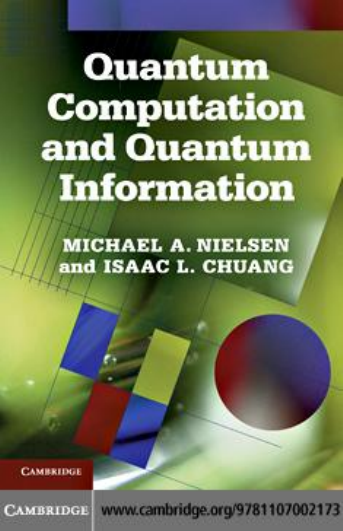

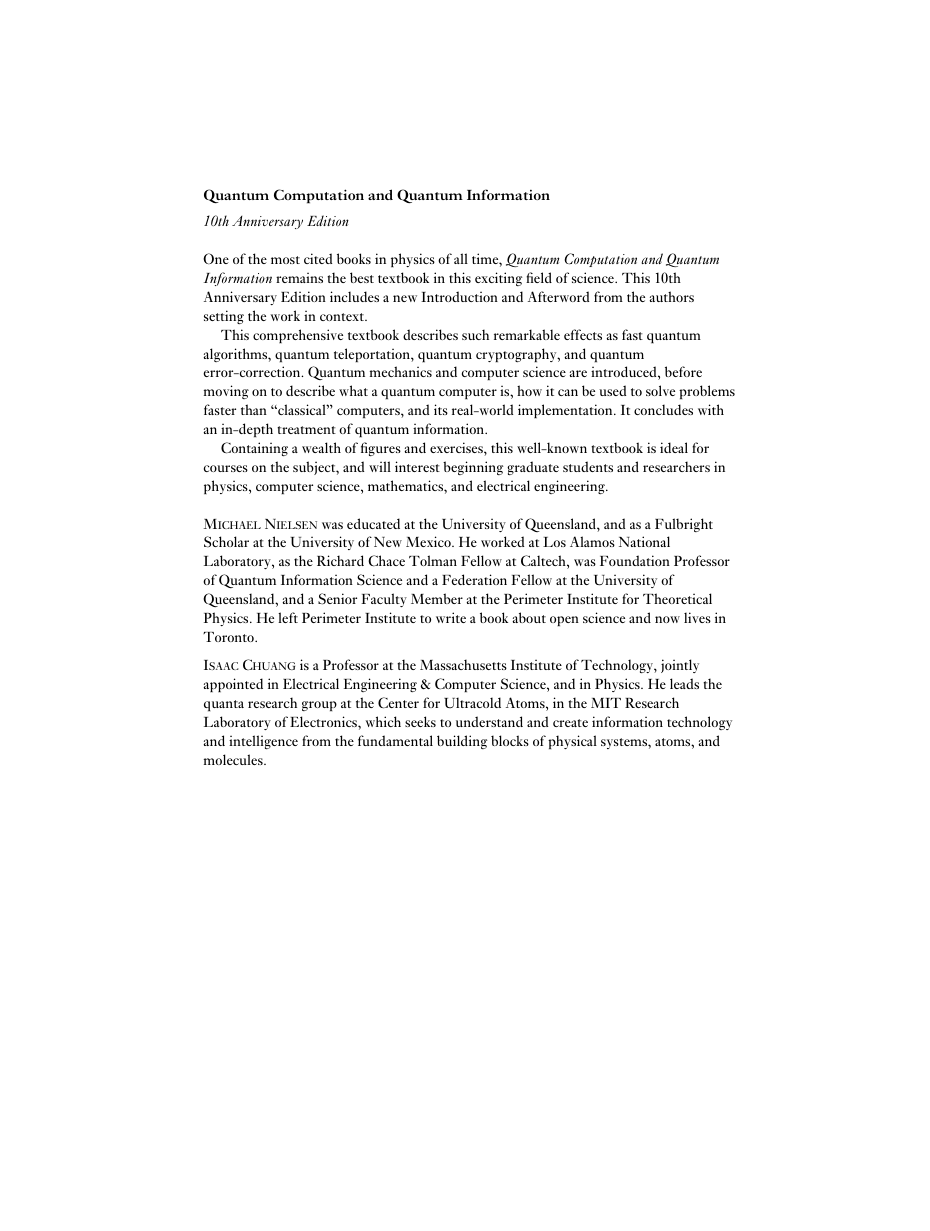
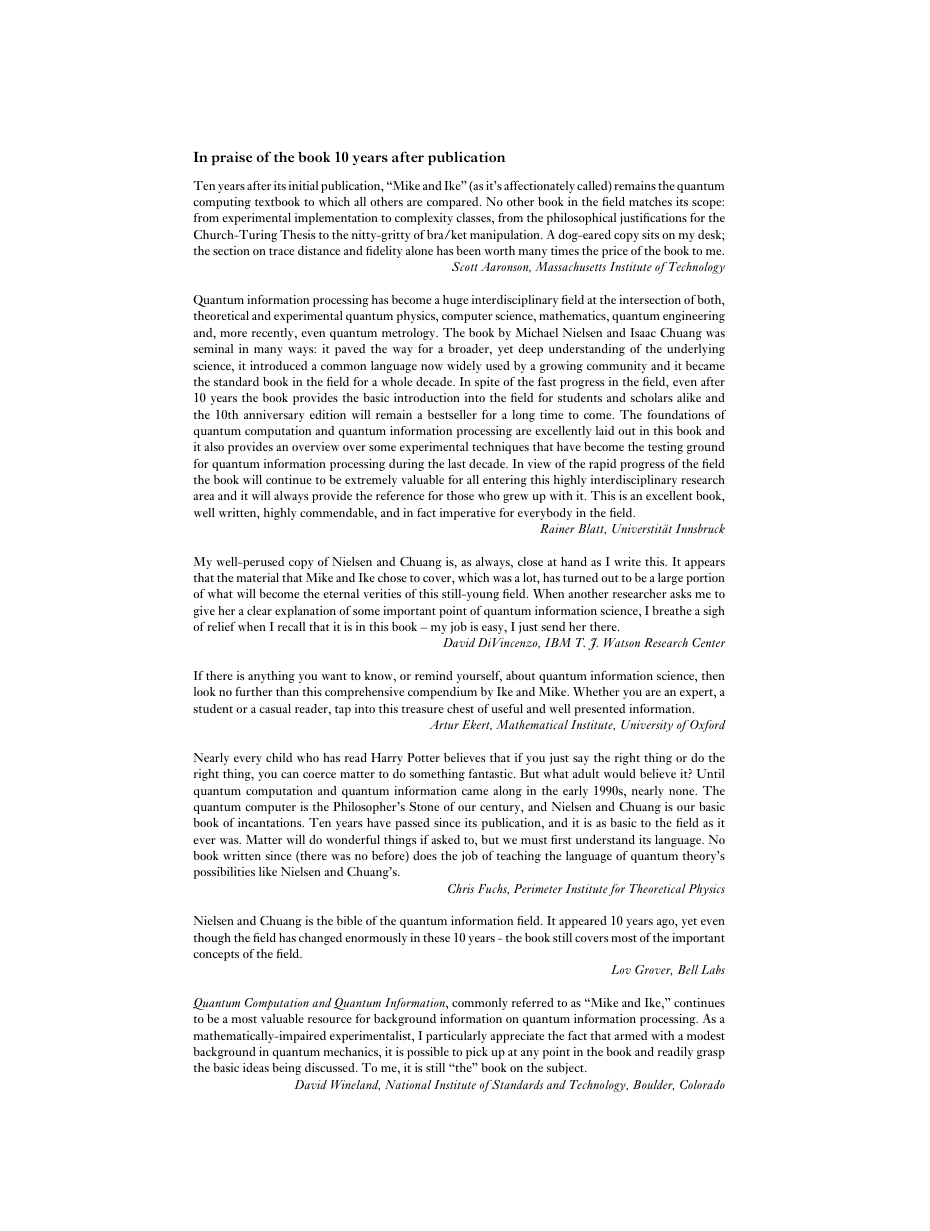


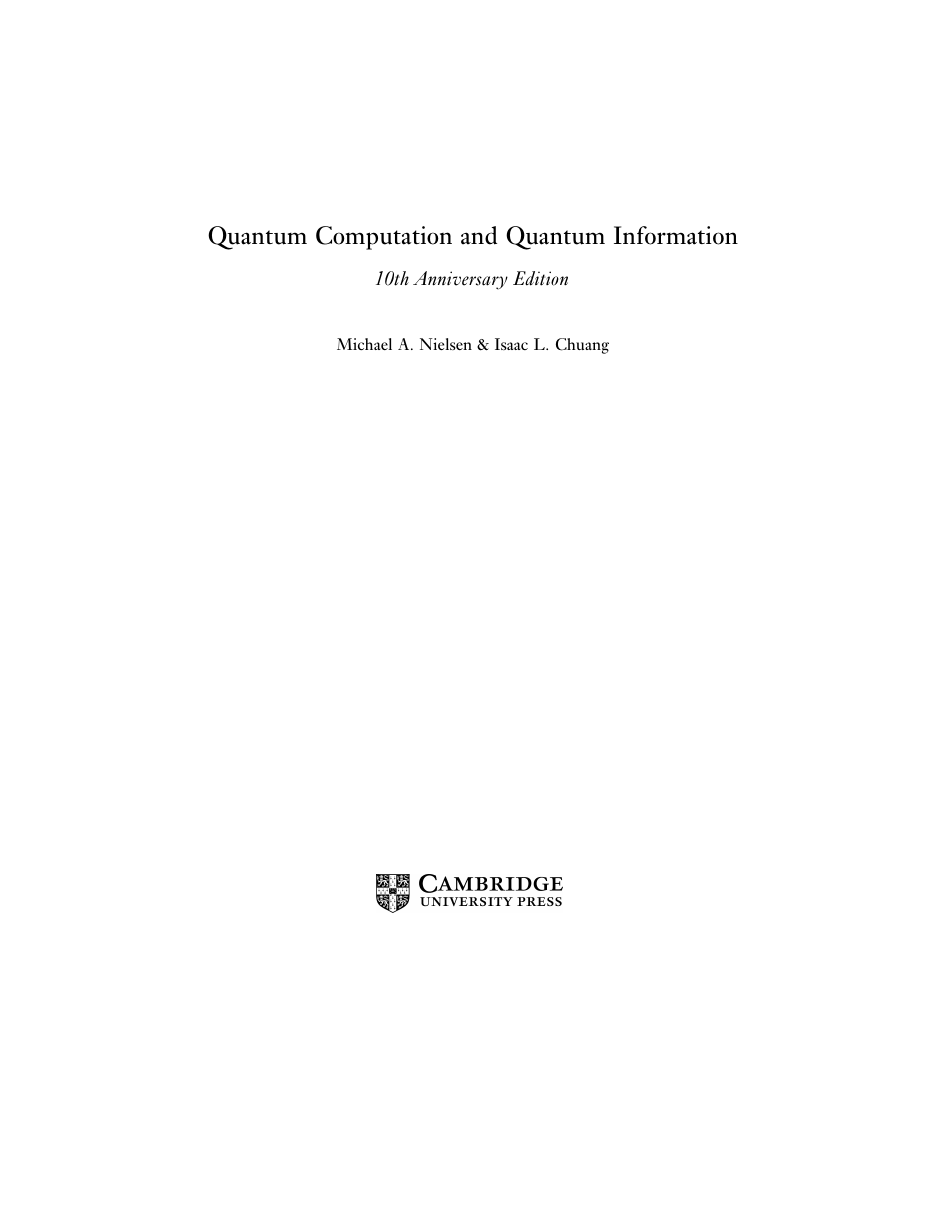
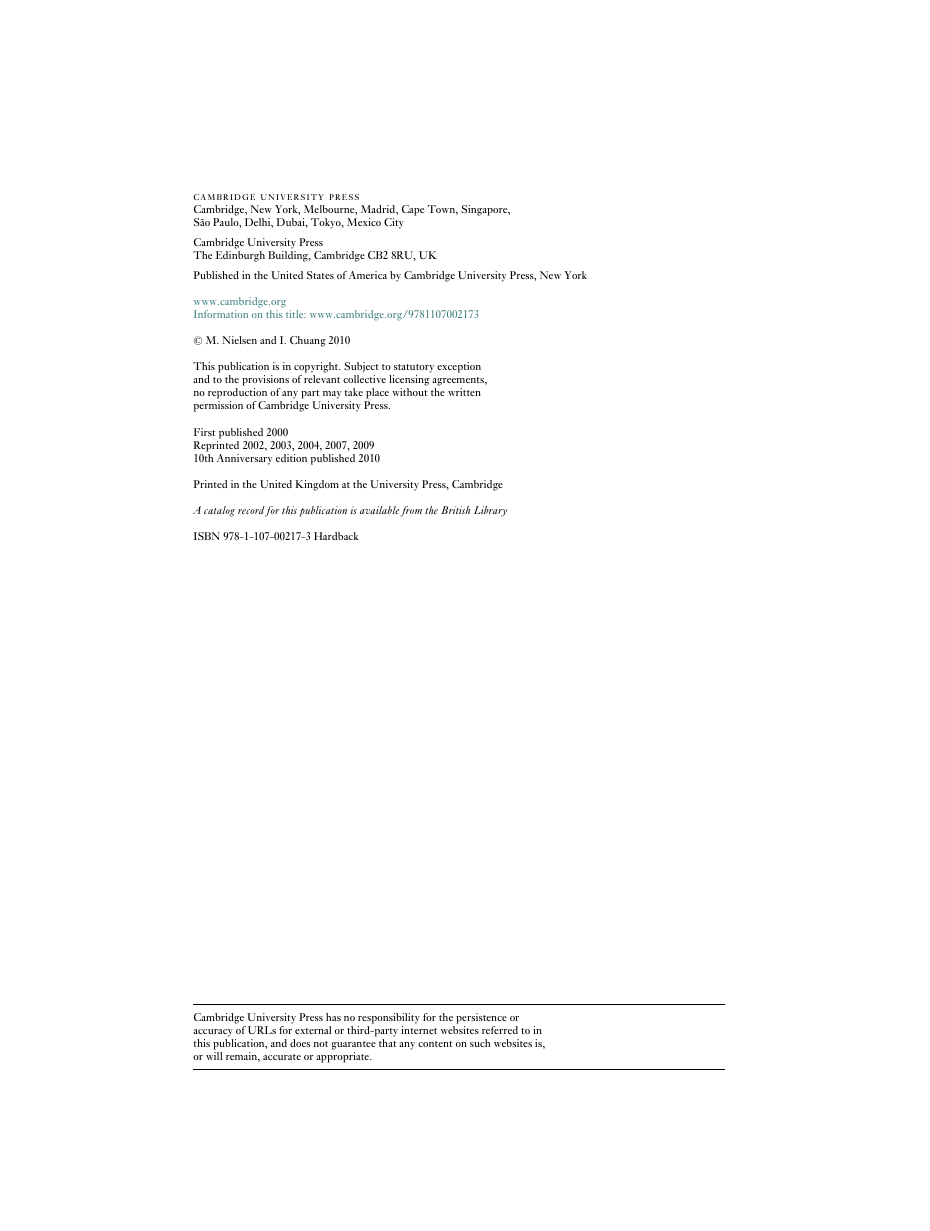








 2023年江西萍乡中考道德与法治真题及答案.doc
2023年江西萍乡中考道德与法治真题及答案.doc 2012年重庆南川中考生物真题及答案.doc
2012年重庆南川中考生物真题及答案.doc 2013年江西师范大学地理学综合及文艺理论基础考研真题.doc
2013年江西师范大学地理学综合及文艺理论基础考研真题.doc 2020年四川甘孜小升初语文真题及答案I卷.doc
2020年四川甘孜小升初语文真题及答案I卷.doc 2020年注册岩土工程师专业基础考试真题及答案.doc
2020年注册岩土工程师专业基础考试真题及答案.doc 2023-2024学年福建省厦门市九年级上学期数学月考试题及答案.doc
2023-2024学年福建省厦门市九年级上学期数学月考试题及答案.doc 2021-2022学年辽宁省沈阳市大东区九年级上学期语文期末试题及答案.doc
2021-2022学年辽宁省沈阳市大东区九年级上学期语文期末试题及答案.doc 2022-2023学年北京东城区初三第一学期物理期末试卷及答案.doc
2022-2023学年北京东城区初三第一学期物理期末试卷及答案.doc 2018上半年江西教师资格初中地理学科知识与教学能力真题及答案.doc
2018上半年江西教师资格初中地理学科知识与教学能力真题及答案.doc 2012年河北国家公务员申论考试真题及答案-省级.doc
2012年河北国家公务员申论考试真题及答案-省级.doc 2020-2021学年江苏省扬州市江都区邵樊片九年级上学期数学第一次质量检测试题及答案.doc
2020-2021学年江苏省扬州市江都区邵樊片九年级上学期数学第一次质量检测试题及答案.doc 2022下半年黑龙江教师资格证中学综合素质真题及答案.doc
2022下半年黑龙江教师资格证中学综合素质真题及答案.doc